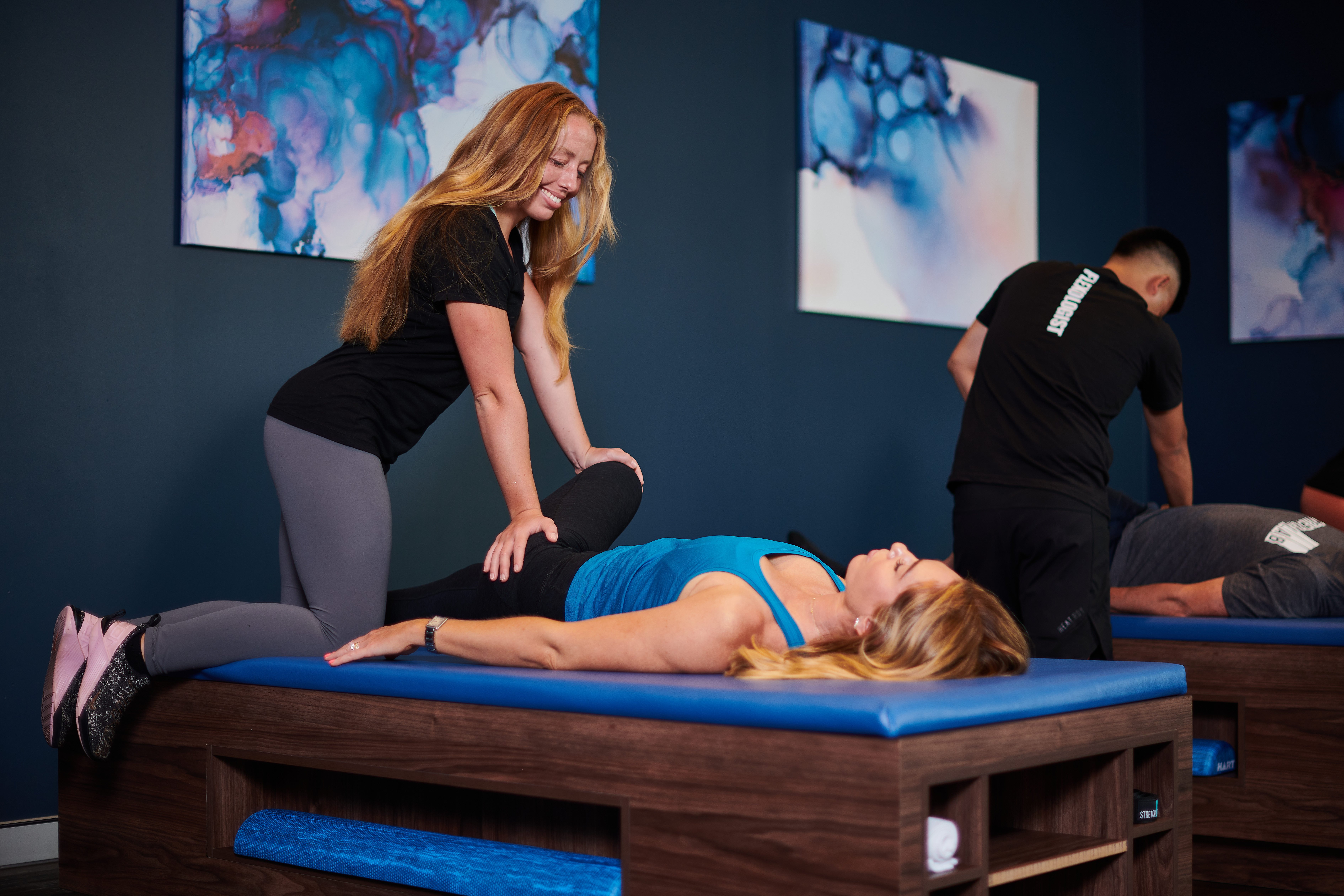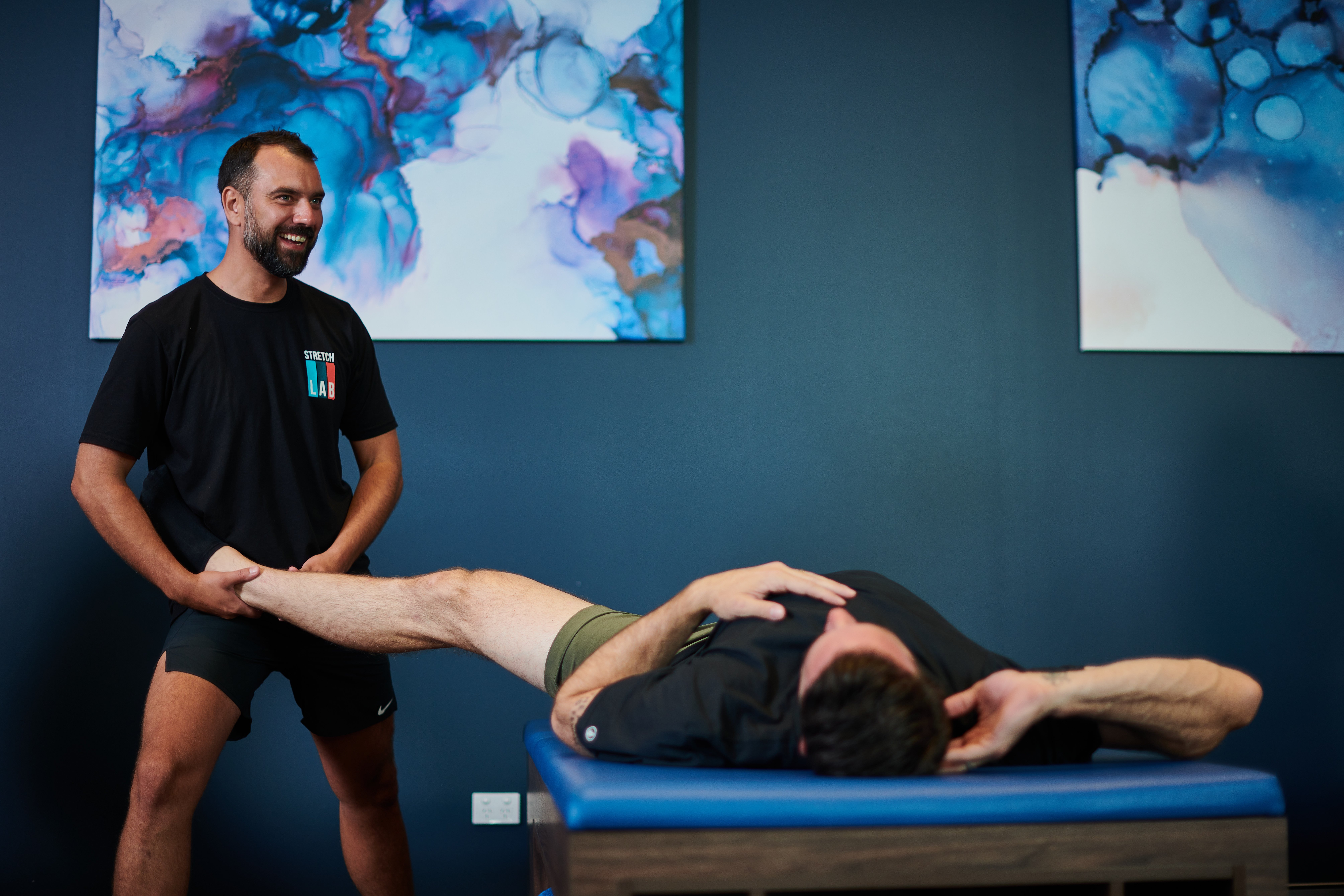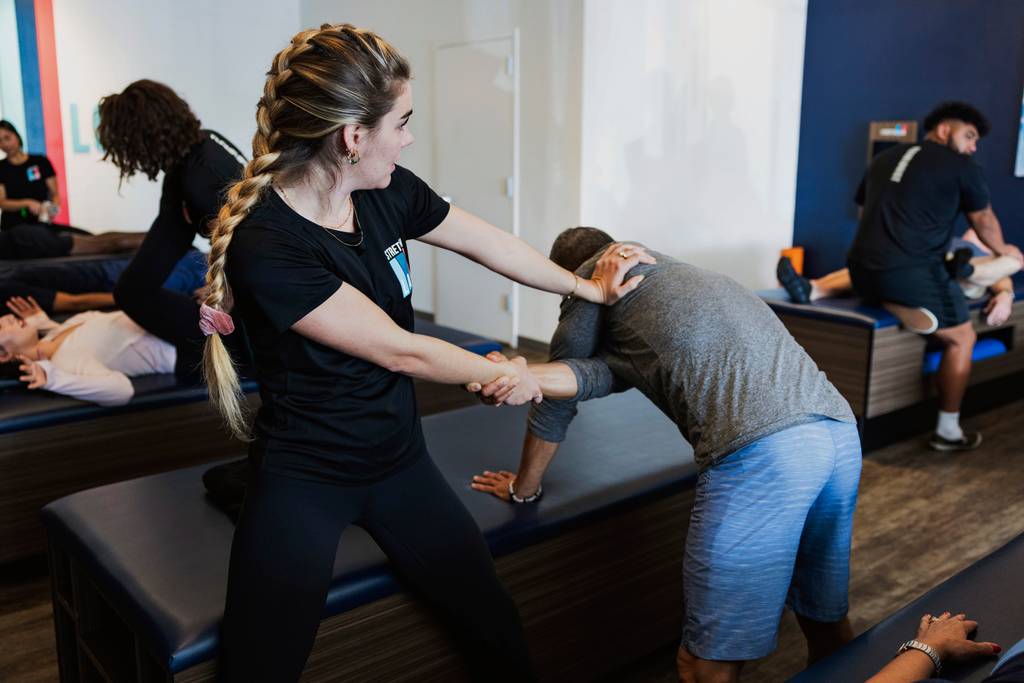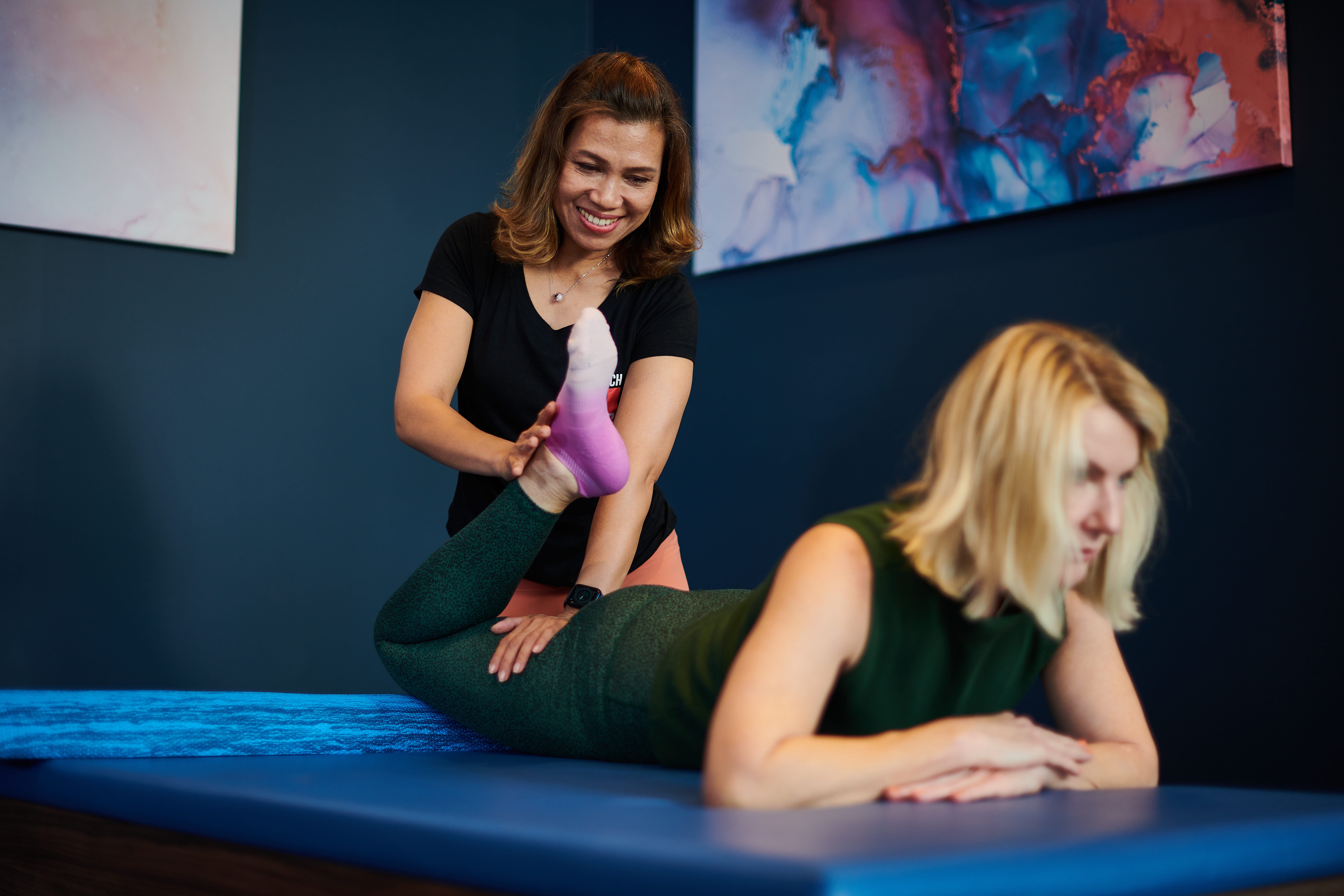When it comes to fitness, many of us will prioritise sweat-inducing workouts and calorie-burning exercises. However, there is one important technique that is often overlooked - stretching!
Stretching is a great way to improve flexibility, prevent muscle tightness, and reduce the risk of injury. It gives our body and muscles the opportunity to lengthen and loosen, which reduces stiffness and improves range of motion.
Whether you're an avid athlete or someone who spends long hours at a desk, stretching is essential for maintaining a healthy, functional body. Yet, it’s a step that many of us may skip in both our day-to-day lives and fitness routines. That’s where stretching classes come in!
In this post, we uncover some of the top things you need to know about stretching classes and how you can get the most out of your session.
What Is A Stretching Class?
It’s exactly as the name says - A fitness class that focuses on stretching and flexibility!
For many of us, our goal when it comes to exercise is to get fit, lose weight or build muscle. As a result, many exercisers will focus on the workout and neglect preparation and recovery. That’s why assisted stretch and flexibility studios like Stretch Lab put a strong emphasis on the more gentle and restorative parts of a workout.
The main goal of stretch classes, which are taught by expert instructors, is to help participants learn the proper techniques for stretching various muscle groups. Our assisted stretching classes also offer a variety of techniques, including static stretching, dynamic stretching, and proprioceptive neuromuscular facilitation (PNF) stretching.
The Benefits Of Stretching
Did you know that you can stretch whenever and wherever you want? It's not just for workouts and offers benefits both inside and outside the gym, field and studio.
- Reduces Risk Of Injury
- Stress Relief
- Improves Flexibility & Mobility
- Improves Workout Performance
- Increase Blood Flow To The Muscles
- Improves Posture
- Calms The Mind & Focuses On Mindfulness
Read More: Enhance Your Flexibility: Enrol in Our Stretch and Flexibility Class

What You Need To Know About Stretching Classes
Before you take on a stretching class, here are some of the top things you should know:
1. Finding The Right Class
Your fitness journey is unique to you. So, when looking for a stretching class, it is important to go with what you feel is best. Here are some factors to consider:
- Qualified Instructors: Look for classes led by instructors who are experienced in teaching stretching techniques and are knowledgeable about anatomy and physiology. This ensures they can guide you through proper form and technique.
- Location and Schedule: Choose a class that is conveniently located and offers timings that suit your schedule. This will make it easier for you to commit to regularly attending classes and maintain a consistent stretching routine.
- Class Size and Atmosphere: Some people prefer smaller classes for more personalised attention, while others enjoy the energy and motivation of larger groups. Consider what atmosphere works best for you and your fitness goals.
- Reviews and Recommendations: Before committing to a class, take the time to read reviews and recommendations from others who have attended. This can provide valuable insight into the quality of instruction and overall experience.
- Trial Classes: Many stretching classes offer trial sessions or introductory offers. Take advantage of these opportunities to try out different classes and instructors to find the right fit for you before making a long-term commitment!
In Sydney? Stretch Lab offers a variety of prominent stretching classes, with studios located in Parramatta, North Strathfield, Gladesville, Five Dock, St Leonards, Darlinghurst, Double Bay, and Randwick.

2. Tips To Get The Most Out Of Your Session
You’ve got a class scheduled! That’s great! Now it’s time to make the most out of your session. Here are some tips to help you maximise the benefits:
Warm-up Before Stretching
But stretching is supposed to be the warm-up, right? While this is true, assisted stretching classes often focus on deep, targeted stretches that require your muscles to be warm and ready.
Before diving into a class, consider doing a light cardiovascular warm-up, such as brisk walking or jogging, for 5-10 minutes to increase blood flow to your muscles and prepare them for stretching. This will enhance the effectiveness of the stretches and reduce the risk of injury.
Stay Hydrated
Staying hydrated is crucial before, during, and after your stretching class. Make sure to drink water throughout the day leading up to your session to ensure your muscles are adequately hydrated. During the class, keep a water bottle nearby and take small sips as needed. Replenishing lost fluids after your session is equally important to help your muscles recover and prevent stiffness.
Focus on Proper Form and Technique
Pay attention to your form and technique during each stretching exercise. It's important to maintain proper alignment and avoid bouncing or jerking movements, as this can lead to muscle strain.
The benefit of a stretching class is that your instructor can provide guidance and corrections to ensure you're performing each stretch correctly.
They'll offer cues on how to adjust your body position and posture to target the intended muscles effectively. Take advantage of their expertise and ask questions if you're unsure about any aspect of the technique.
Breathe and Relax
Allow your breath to flow naturally and deeply as you move through each stretch, focusing on inhaling deeply through your nose and exhaling fully through your mouth.
Consciously relaxing your muscles during a stretching class can help release tension and improve the effectiveness of the stretch.
Stay Consistent
Consistency is key when it comes to stretching. Aim to attend stretching classes regularly and incorporate the stretching techniques you’ve learned into your daily routine.
Consistent practice will yield better results and will help you maintain better flexibility over the long term. With Stretch Lab's membership options, you can enjoy the benefits of regular stretching and maintain flexibility over the long term.
Wear Comfortable Clothing
Be sure to wear comfortable clothing that allows for a full range of motion during your stretching class. Opt for breathable fabrics that won't restrict your movements or cause discomfort.
Loose-fitting clothing, such as athletic wear or yoga pants, is ideal for allowing your body to move freely. Avoid clothing with zippers, buttons, or seams that could dig into your skin during stretches.
Remember, the goal is to feel comfortable and unrestricted so you can focus on your flexibility and relaxation.
Read More: Beyond Exercise: How Stretching Completes Your Fitness Routine

3. Avoid These Common Mistakes
While stretching is highly beneficial, if not done correctly these mistakes can hinder your progress and increase the risk of injury. Here are some mistakes to avoid during stretching exercises:
- Bouncing or Jerking Movements: Avoid using momentum or bouncing movements while stretching. This can cause muscle strain and increase the risk of injury. Instead, focus on smooth, controlled movements.
- Overstretching: Stretching should create a gentle pull or tension in the muscles, but it should never be painful. While it is important to challenge yourself, it is just as important to listen to your body. f you experience pain or discomfort, ease off the stretch or ask for modifications.
- Holding Your Breath: It's common for people to hold their breath while stretching. However, this can increase muscle tension and hinder the effectiveness of the stretch. Breathing deeply, on the other hand, will help relax your muscles.
- Neglecting Opposing Muscle Groups: Many people tend to only focus on stretching the muscles they use most frequently, such as the hamstrings or quadriceps. However, it's important to stretch opposing muscle groups as well. This helps maintain balance and prevent muscle imbalances.
Read More: What is PNF Stretching?

4. Equipment Used In A Stretching Class
You may be most familiar with stretching that requires no equipment – just you and your body. But, did you know that there are different props and equipment that can enhance your routine and provide additional support? At home you may use a yoga mat and a wall to help you stretch better, but during your stretch class, you may encounter:
- Studio Beds: Many stretch studios are equipped with comfortable beds. They offer a supportive surface for stretching and other exercises, ensuring comfort and stability throughout your session.
- Foam Roller: Foam rollers are tools made of foam or rubber. They are used to release muscle tension and improve flexibility by applying pressure to specific muscle groups. Foam rolling is often used as part of a warm-up or cool-down routine.
- Massage Balls: Massage balls are small, portable balls used for self-massage and targeted muscle relief. They can help release tension, improve circulation, and reduce soreness. Massage balls are available in different sizes and textures to suit individual needs.
- Stretching Strap: This is a long, flexible strap (similar to a large rubber band) that can be used to assist in stretch exercises. It helps you reach deeper into stretches and provides support for challenging poses.
- Massage Guns: Massage guns, also known as percussion massagers, are handheld devices that provide deep tissue massage. They help relieve muscle soreness, improve circulation, and increase range of motion.

5. Types Of Stretch Classes
Many studios offer a variety of classes that cater to the skills and goals of each individual. Whether you're a beginner or an advanced athlete, there are assisted stretching classes designed to meet your specific needs. At Stretch Lab, we offer the following class types for individuals of all body types, skills and fitness levels:
One-on-one Stretches
For participants looking for a more personalised approach to their stretching routine, one-on-one classes are ideal. These are highly targeted and focus on your unique requirements, whether you are looking to target a problem area or a specific muscle group. One-on-one sessions are also great for beginners as this gives them personal attention and guidance to perfect their techniques.
For a comprehensive full-body stretch, our standard 50-minute session is recommended. It targets all major muscle groups and extremities, improving range of motion and flexibility while also helping to loosen tight muscles and ease stiff joints.
Additionally, our maintenance 25-minute stretch is perfect for those looking for a workout that maintains flexibility without causing strain. This class has even been recognised by the rowing community for its effectiveness!
Group Stretches
Ideal for both beginners and experts, our group classes can accommodate up to six participants at a time. They offer a fun and exciting experience, led by trained Flexologists who offer guidance and support.
These classes, available at selected studios, include a series of seated and standing stretching positions, along with instructions on using stretching tools like stretch straps and foam rollers. Regardless of your current flexibility level, anyone looking to kick-start or enhance their flexibility journey is welcome in these sessions!

Incorporate Stretching Into Your Daily Routine Today!
Incorporating stretching into your fitness routine offers a wide range of benefits, from improving flexibility and preventing injuries to enhancing overall performance and reducing stress. Stretch classes are a great way to encourage and motivate individuals to prioritise stretching in their workouts.
These classes provide the knowledge, guidance, and support needed to make the most out of your stretch sessions. Whether you're a beginner looking to improve flexibility or an athlete aiming to optimise performance, our stretch classes offer tailored sessions led by experienced instructors.
So, why wait? If you're ready to take your fitness to the next level and enjoy the many advantages of stretching, consider joining a stretching class. Embrace the journey towards improved flexibility, increased energy levels, and a healthier, more active lifestyle. Your body will thank you!



